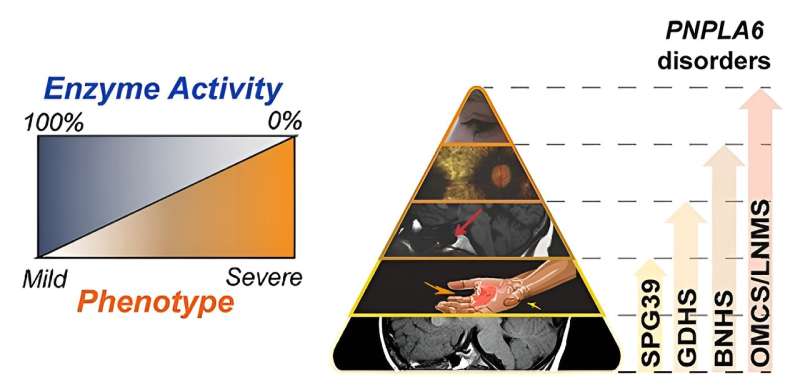This article has been reviewed according to Science X's editorial process and policies. Editors have highlighted the following attributes while ensuring the content's credibility:
fact-checked
peer-reviewed publication
trusted source
proofread
Scientists unravel genetic basis for neurodegenerative disorders that affect vision

Led by researchers at the National Institutes of Health (NIH), a team of scientists has uncovered the complex molecular mechanisms underlying neurodegenerative disorders linked to the gene PNPLA6, which encompass a range of conditions affecting mobility, vision, and hormonal regulation.
Published
in the journal Brain, the research offers a deeper understanding of PNPLA6-related conditions at clinical, genetic, and molecular levels, paving the way for tailored diagnostic and therapeutic approaches. PNPLA6-related disorders arise due to mutations that impair the function of an enzyme involved in the regulation of lipid metabolism and membrane stability within neurons, known as neuropathy target esterase (NTE). Inhibition of NTE activity has been linked to neurological disorders such as organophosphate-induced delayed neuropathy,
Robert Hufnagel, M.D., Ph.D., and colleagues at the NIH's National Eye Institute (NEI) Ophthalmic and Visual Function Branch, conducted a systematic review and analysis of data from more than 100 patients with PNPLA6 mutations. Using neuroimaging, electrophysiological studies (where neurons' electrical signals are measured and analyzed to understand their function and properties), and genetic testing information, the researchers meticulously evaluated mobility, vision, and hormone expression.
Results revealed that symptom severity is driven by single substitutions in the DNA code "building blocks" or nucleotides—adenine (A), thymine (T), cytosine (C), and guanine (G), called missense mutations. Each combination of three letters (ATC, or TCG, for example) determines an amino acid, which is the basis of all proteins. When a missense variant occurs, it can affect how the protein functions, potentially leading to health issues.
How these mutations affect NTE function depends on where they occur in the PNPLA6 gene.
In the study, researchers also recreated mouse models bearing the same missense mutations observed in patients. They then developed a series of tests to categorize the PNPLA6 variants according to disease severity. By conducting these tests in mice, scientists noted a correlation between the activity of NTE and the severity of PNPLA6-associated symptoms.
"In our mouse experiments, we observed that greater NTE activity associated with less profound disease," said James Liu, a postdoctoral research fellow at NEI and an author of the study. "This knowledge will enable us to learn more about the spectrum of PNPLA6-related diseases in humans and positions us for future clinical trials, potentially using NTE as a biomarker."
More information: James Liu et al, Neuropathy target esterase activity defines phenotypes among PNPLA6 disorders, Brain (2024). DOI: 10.1093/brain/awae055




















